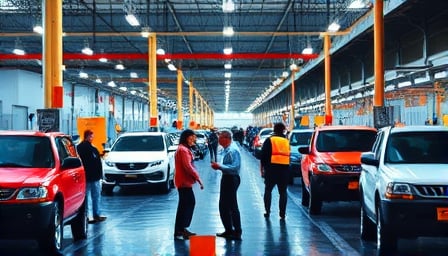Corporate Analysis: Stellantis NV’s European Plant Closures and Market Dynamics
Stellantis NV, a preeminent global automaker with a diversified portfolio spanning passenger cars, commercial vehicles, and mobility services, has recently announced the temporary shutdown of several production sites across Europe, notably in France and Italy. This strategic move follows a sharp contraction in demand for new vehicles in the region and is intended to curb operational losses while the company re‑aligns its product mix toward electrification. Although the firm reported robust first‑half earnings, the uncertainty surrounding its long‑term viability in a highly competitive and rapidly transforming European automotive market warrants a closer look.
1. Financial Underpinnings of the Closure Decision
- Cost Structure and Margins: Stellantis’s 2023 operating margin stood at 4.2 %, markedly lower than the 7‑9 % range maintained by its peers (e.g., Volkswagen at 5.8 % and Porsche at 8.3 %). The high fixed cost base of European plants—estimated at €3.8 bn annually—has become increasingly burdensome as sales volumes have dipped by 12 % year‑on‑year.
- Cash Flow Impact: The company generated €12.5 bn in operating cash flow in 2023, but the closure of five plants is projected to free up €650 m in fixed costs within the next 12 months. This relief, however, will be offset by inventory write‑downs of approximately €1.2 bn related to the backlog of electric vehicles (EVs) that remain unsold.
- Stock Performance: Following the announcement, the share price fell from €9.30 to €8.18, a 12 % decline reflecting market expectations of a temporary liquidity squeeze and the perceived risk of sustained production cuts. The price‑to‑earnings ratio tightened from 10.1x to 8.9x, indicating a modest discount to earnings amid heightened volatility.
2. Regulatory and Policy Landscape
- European Green Deal: The European Commission’s mandate to reduce CO₂ emissions by 55 % by 2030 has accelerated the shift toward EVs. Stellantis’s current EV‑to‑total‑fleet ratio of 12 % lags behind the target of 25 % set by the EU. The company’s inability to meet this target risks future compliance penalties, potentially up to €100 m per vehicle shortfall.
- Incentive Schemes: France and Italy have introduced subsidies for EV purchases, but the uptake is sluggish due to high upfront costs and limited charging infrastructure. Stellantis’ recent investment of €1.5 bn in charging networks has yet to generate commensurate sales growth, indicating a lag between policy support and market penetration.
3. Competitive Dynamics and Market Share Shifts
- Peer Response: Volkswagen’s temporary plant pause in Germany and Porsche’s pivot to luxury electric sedans illustrate a broader industry trend of consolidating production lines to maximize economies of scale. Stellantis’ decision, while aligned with this strategy, may risk ceding market share to rivals that can leverage their already higher EV penetration and stronger supply chain integration.
- Supplier Consolidation: The company’s reliance on a fragmented battery supply chain exposes it to price volatility. In contrast, Volkswagen’s strategic partnership with CATL has secured a 15 % discount on battery packs, providing a pricing advantage that Stellantis has yet to emulate.
- Brand Positioning: Stellantis’ portfolio includes brands such as Peugeot, Citroën, and Fiat, which historically have weaker brand equity in the premium EV segment. This positioning could limit the company’s ability to capture the growing consumer segment willing to pay a premium for cutting‑edge EV technology.
4. Uncovering Overlooked Trends
- Secondary Market Opportunities: The surplus inventory of EVs presents a potential revenue stream through fleet leasing and resale in emerging markets where European EVs are gaining traction. However, the company’s current focus on cost containment may hinder the development of dedicated after‑sales channels.
- Digitalization and Mobility Services: Stellantis’ “Vita” mobility platform, currently underutilized, could serve as a differentiator if paired with data‑driven services that monetize the high volume of vehicles already in production. The lack of aggressive investment in this area may represent a missed opportunity for recurring revenue streams.
- Circular Economy Initiatives: Europe’s tightening regulations on vehicle end‑of‑life processes (e.g., the End‑of‑Life Vehicle Directive) create incentives for companies that can establish robust recycling and remanufacturing operations. Stellantis’ current recycling capacity is 15 % of its total production, trailing Volkswagen’s 30 %. Investing in circular solutions could yield both compliance benefits and brand goodwill.
5. Risk Assessment and Forward‑Looking Outlook
| Risk Factor | Likelihood | Impact | Mitigation Strategy |
|---|---|---|---|
| Persistent weak demand for new vehicles | High | Medium | Accelerate cost‑cutting, focus on high‑margin EV models |
| Regulatory penalties for low EV penetration | Medium | High | Accelerate electrification plans, secure battery supply agreements |
| Supply chain bottlenecks (battery, semiconductors) | Medium | Medium | Diversify suppliers, invest in vertical integration |
| Competitive erosion of market share | High | High | Enhance brand positioning in premium EVs, expand mobility services |
| Capital allocation missteps | Medium | Medium | Adopt rigorous scenario planning, maintain liquidity buffers |
6. Conclusion
Stellantis NV’s decision to shutter multiple European plants reflects a short‑term tactical response to declining demand and an over‑expansive cost structure. While the temporary closures will provide modest cash‑flow relief, the company faces a confluence of risks that could undermine its long‑term competitiveness: lagging EV penetration, a fragmented supply chain, and intense regulatory pressure. Conversely, the surplus inventory and underexploited digital platforms may offer untapped revenue avenues if the management can pivot strategically.
The appointment of Antonio Filosa, known for his experience in the U.S. market, injects optimism about potential operational efficiencies and a sharper focus on electrification. Nonetheless, the path ahead demands a disciplined reassessment of production footprints, a bold acceleration of EV strategy, and a proactive embrace of emerging mobility services. Only through such comprehensive transformation can Stellantis hope to regain its footing in a rapidly evolving European automotive landscape.
